NURS FPX 6410 Presentation to Informatics Staff Paper Example
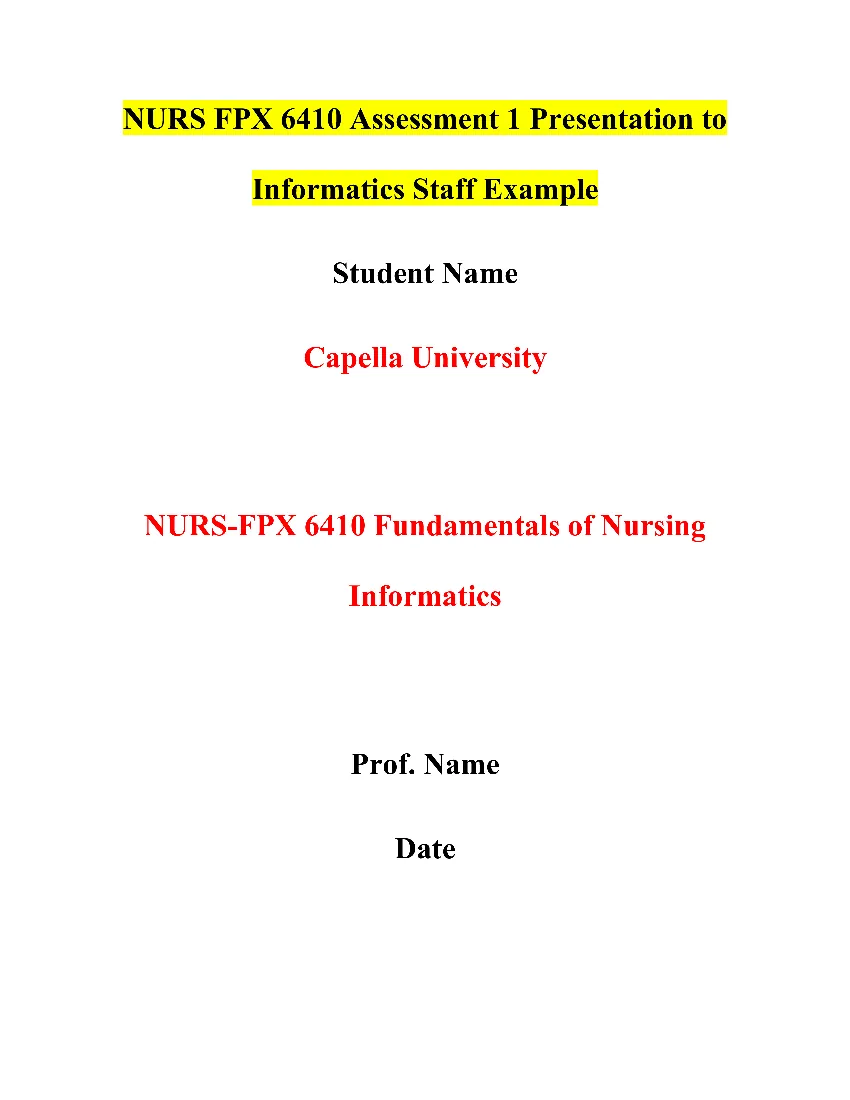 NURS FPX 6410 Assessment 1 Presentation to Informatics Staff
NURS FPX 6410 Assessment 1 Presentation to Informatics Staff
NURS FPX 6410 Presentation to Informatics Staff Paper Assignment Brief
Course: NURS-FPX 6410 Fundamentals of Nursing Informatics
Assignment Title: NURS FPX 6410 Assessment 1 Presentation to Informatics Staff
Assignment Overview
This assignment aims to assess your understanding of how nursing informatics integrates with American Nurses Association (ANA) standards to enhance quality outcomes in healthcare organizations. As part of this assignment, you will create a Kaltura presentation for informatics staff, exploring the relationship between ANA standards, data utilization, and quality outcomes.
Understanding Assignment Objectives
In this assignment, you will demonstrate your ability to:
- Apply theoretical frameworks and models of nursing informatics to professional nursing practice.
- Apply standards of practice in nursing informatics to address gaps in practice in healthcare organizations.
- Analyze how regulatory bodies, rules, regulations, and requirements impact the use of health information technology in nursing practice and organizational operations.
- Integrate ethical and legal practices into delivering quality healthcare using technology in various environments.
- Communicate with internal and external stakeholders to ensure accurate and efficient transmission of data, information, and plans.
- Communicate as a practitioner-scholar, consistent with the expectations of a nursing professional.
The Student’s Role
You are tasked with presenting as the Director of Nursing Informatics to informatics staff. Your role is to provide insights into the relationship between ANA standards and quality outcomes, emphasizing the significance of data utilization in strengthening healthcare outcomes.
Competencies Measured
The competencies assessed in this assignment include:
- Apply theoretical frameworks and models of nursing informatics.
- Apply standards of practice in nursing informatics.
- Analyze the impact of regulatory bodies on health information technology.
- Integrate ethical and legal practices into healthcare delivery.
- Communicate effectively with stakeholders.
- Demonstrate professionalism and scholarly communication.
You Can Also Check Other Related Assessments for the NURS-FPX 6410 Fundamentals of Nursing Informatics Course:
NURS FPX 6410 Assessment 2 Executive Summary to Administration Example
NURS FPX 6410 Assessment 3 Exploration of Regulations and Implications for Practice Example
NURS FPX 6410 Presentation to Informatics Staff Paper Example
Slide 1: Title Slide
Title: Enhancing Quality Outcomes in Healthcare Organizations through Nursing Informatics: Integrating ANA Standards and Data Utilization
Presenter: Abigail, Director of Nursing Informatics
Date: April 5, 2024
Faculty: [Faculty Name]
Slide 2: Introduction
- Good morning/afternoon, esteemed colleagues. I’m Abigail, the Director of Nursing Informatics, and I’m delighted to guide you through today’s presentation.
- As Director of Nursing Informatics, it’s my privilege to discuss how the integration of ANA standards and data utilization can drive improvements in healthcare outcomes.
- Today, we’ll delve into the importance of adhering to ANA standards, distinguishing between validated and invalidated data, identifying gaps in practice, and considering legal and ethical practices in our decision-making processes.
- Our focus will be on the symbiotic relationship between the American Nurses Association (ANA) standards and the effective utilization of data within the realm of nursing informatics.
- By the end of our session, I aim to underscore how this integration can significantly enhance the quality outcomes in healthcare organizations.
Slide 3: Key Stakeholders
- In our audience today, we have Nurse Informaticists, Clinical Informaticists, and Informatics Specialists, among others.
- Nurse Informaticists play a critical role in bridging the gap between nursing practice and information technology, ensuring the effective implementation of informatics solutions.
- Clinical Informaticists leverage data and technology to improve clinical workflows and patient care outcomes, while Informatics Specialists provide technical expertise in managing healthcare information systems.
- By participating in this presentation, each of you will gain insights into how aligning with ANA standards and leveraging data effectively can enhance your contributions to healthcare quality and patient outcomes.
Slide 4: ANA Standards
- The ANA standards serve as guiding principles for nursing practice, outlining expectations for professional conduct and performance.
- As highlighted in the ANA’s Nursing Informatics: Scope and Standards of Practice, adherence to these standards ensures consistency, accountability, and quality in nursing care delivery (American Nurses Association, 2015).
- By following ANA standards, we uphold the integrity of our profession and prioritize the well-being of our patients.
Slide 5: Validated vs. Invalidated Data
- Validated data refers to information that has undergone rigorous scrutiny and verification processes, ensuring its accuracy and reliability.
- In contrast, invalidated data lack credibility and may lead to erroneous conclusions if relied upon.
- Distinguishing between the two is paramount in ensuring the integrity of our decision-making processes and the effectiveness of our interventions (Bossen et al., 2019).
Slide 6: Identifying Gaps in Practice
- Validated data play a crucial role in identifying gaps in practice, providing us with actionable insights to drive quality improvement initiatives.
- By analyzing validated data, we can pinpoint areas of inefficiency, inconsistency, or non-compliance with best practices (Kislaya et al., 2020).
- This enables us to implement targeted interventions aimed at enhancing patient outcomes and optimizing resource utilization.
Slide 7: Legal and Ethical Practice
- Legal and ethical considerations are integral to our practice as nursing informaticists.
- Adhering to relevant laws, regulations, and ethical principles safeguards patient confidentiality, privacy, and autonomy.
- By integrating legal and ethical practices into our workflows, we uphold professional standards and mitigate the risk of legal and ethical dilemmas arising from our actions (Varkey, 2021).
Slide 8: Theoretical Frameworks and Models
- Theoretical frameworks and models provide us with conceptual frameworks to guide our understanding and application of nursing informatics principles.
- These frameworks offer structured approaches to problem-solving, decision-making, and practice development (McGonigle & Mastrian, 2022).
- By grounding our practice in theoretical foundations, we can effectively navigate complex challenges and drive innovation in healthcare delivery.
Slide 9: Practice Example – Theoretical Framework/Model
- Let’s consider a hypothetical practice example where we’re implementing a new electronic health record (EHR) system in our healthcare facility.
- To guide our approach, we’ll apply the Systems Theory framework, which emphasizes the interconnectedness of various components within a system (McGonigle & Mastrian, 2022).
- This framework will help us understand the dynamic interactions between technology, processes, and human factors in EHR implementation and optimization.
Slide 10: Practice Example – Regulatory Bodies
- In the context of our EHR implementation example, several regulatory bodies come into play, including the Health Insurance Portability and Accountability Act (HIPAA) and the Office of the National Coordinator for Health Information Technology (ONC).
- Compliance with these regulatory standards is essential for safeguarding patient data security, privacy, and interoperability (Moore & Frye, 2019).
- By aligning with regulatory requirements, we ensure the integrity and legality of our EHR implementation efforts.
Slide 11: Practice Example – Legal and Ethical Practices
- Legal and ethical considerations in our EHR implementation extend to issues such as patient consent, data privacy, and data security.
- Ensuring informed consent from patients regarding the use and disclosure of their health information is paramount.
- Additionally, maintaining data integrity and confidentiality aligns with ethical principles of beneficence and non-maleficence (Varkey, 2021).
Slide 12: Practice Example – Validated Data
- Validated data analysis is instrumental in assessing the effectiveness and impact of our EHR implementation on patient outcomes and organizational performance.
- By analyzing validated data on key metrics such as medication errors, patient satisfaction, and workflow efficiency, we can evaluate the success of our EHR initiative and identify areas for further improvement (Kislaya et al., 2020).
- Validated data provide us with actionable insights to drive evidence-based decision-making and quality improvement efforts.
Slide 13: Conclusion
- In conclusion, our exploration of the integration of ANA standards and data utilization in nursing informatics has shed light on the critical role each plays in enhancing quality outcomes in healthcare organizations.
- By adhering to ANA standards, leveraging validated data, and considering legal and ethical principles, we can advance patient-centered care delivery and drive continuous improvement in nursing informatics practices.
- Thank you for your attention, and I invite any questions or discussions on the topics covered today.
Slide 14: References
American Nurses Association. (2015). Nursing informatics: Scope and standards of practice. Silver Spring, MD: American Nurses Association.
Bossen, C., Jensen, L. G., & Schougaard, L. M. (2019). Validity and cross-cultural comparability of the Danish version of the Danish In-Patient Experience Questionnaire: A pilot study. Scandinavian Journal of Caring Sciences, 33(2), 343-353.
Kislaya, I., Santos, A. J., Lyshol, H., Antunes, L., Barreto, M., Gaio, V., & Nunes, B. (2020). Collecting valid and reliable data: Fieldwork monitoring strategies in a health examination survey. Portuguese Journal of Public Health, 38(2), 81-90.
McGonigle, D., & Mastrian, K. (2022). Nursing informatics and the foundation of knowledge (5th ed.). Burlington, MA: Jones & Bartlett Learning.
Moore, W., & Frye, S. (2019). Review of HIPAA, part 1: History, protected health information, and privacy and security rules. Journal of nuclear medicine technology, 47(4), 269-272.
Varkey, B. (2021). Principles of clinical ethics and their application to practice. Medical Principles and Practice, 30(1), 17-28.
Detailed Assessment Instructions for the NURS FPX 6410 Presentation to Informatics Staff Paper Assignment
Introduction
This assessment explores your understanding of how the field of nursing informatics integrates with American Nurses Association (ANA) standards of practice to enhance quality outcomes for health care organizations.
Instructions
Imagine that you are a director of nursing informatics and have decided to give a presentation to staff about the relationship between the American Nurses Association (ANA) standards and quality outcomes and how data can contribute to strengthening and enhancing those outcomes.
Present the topic to your staff in a Kaltura presentation that is 10 minutes or less in length. The goal is to create a presentation to stakeholders that ensures accurate and efficient transmission of data, information, and plans.
The presentation should consist of no more than 10–12 PowerPoint slides, which should include the following with speaker’s notes:
- Title slide.
- Develop a general overview about the use of standards in practice. Briefly describe:
- How validated data can identify gaps in practice.
- How to distinguish between invalidated and validated data.
- How ethical and legal practices contribute to quality outcomes.
- Why standards are important to follow.
- The value of theoretical frameworks or models used for nursing informatics.
- Provide a specific example to illustrate the use of standards in practice.
- Apply a theoretical framework or model in practice to this example.
- Analyze the specific regulatory bodies that apply to this example and how these standards contribute to quality outcomes.
- Evaluate ethical and legal practices that relate to this example.
- In the context of this example, analyze how the use of validated data can help to identify gaps in practice.
- Reference slide.
Include the following in your assignment submission:
- A narrated Kaltura presentation of your PowerPoint slides.
- The full PowerPoint presentation as a separate .ppt or .pptx file, including speaker’s notes in the slides. Note:The speaker’s notes will act as a transcript for your presentation.
When finished, submit the full PowerPoint presentation (with speaker’s notes for the slides) as an attachment. You may submit the assignment only once, so make sure all the components are present before submitting.
Additional Requirements
- Format:Slide presentation with audio narrative.
- Kalturais the preferred presentation platform for Capella University. All Capella learners have access to Kaltura. You will want to have an external or built-in microphone available and tested. Refer to Using Kaltura, listed in Resources, for instructions as needed.
- Audioshould be 10 minutes or less.
- Reference Slide:Include five scholarly sources that support the policy and guidelines. Additional references may be used.
- Graphics:You may use professional-looking graphics.
- Speaker’s Notes:Speaker’s notes are required in place of a narrative paper.
- Presentation Length:10–12 slides with a maximum of five bullets per slide. All information for each bullet stays on one line.
- Title slide:Include your name, course, date, and faculty name.
- Written communication:Written communication is free of errors that detract from the overall message.
- APA formatting:Resources and citations are formatted according to current APA style and formatting.
Review the Presentation to Informatics Staff scoring guide prior to submission to ensure you address all required grading criteria.
Competencies Measured
By successfully completing this assessment, you will demonstrate your proficiency in the following course competencies and assessment criteria:
- Competency 1: Apply theoretical frameworks and models of nursing informatics to professional nursing practice.
- Apply theoretical frameworks or models to show applications in practice.
- Competency 2: Apply standards of practice in nursing informatics to address gaps in practice in a health care organization, practice setting, or community.
- Apply informatics standards of evidence-based practice to address gaps in practice quality.
- Distinguish between invalidated and validated data.
- Competency 3: Analyze how regulatory bodies, rules, regulations, and requirements impact the use of health information technology in nursing practice and organizational operations.
- Analyze how specific regulatory standards apply to your example in the context of quality outcomes.
- Competency 4: Integrate ethical and legal practices into delivering quality health care using technology in various environments.
- Evaluate related ethical and legal practices.
- Competency 5: Communicate with internal and external stakeholders to ensure accurate and efficient transmission of data, information, and plans.
- Demonstrate accurate and efficient transmission of data, information, and plans to key stakeholders.
- Competency 6: Communicate as a practitioner-scholar, consistent with the expectations of a nursing professional.
- Create a professional and engaging presentation.
Reference: to Utilize below
Theoretic Frameworks and Models
- American Nurses Association. (2015). Nursing informatics: Scope and standards of practice (2nd ed.) .
- “The Scope of Nursing Informatics Practice,” pages 1–66.
- McGonigle, D., & Mastrian, K. (2022). Nursing informatics and the foundation of knowledge(5th ed.). Jones & Bartlett. Available in the courseroom via the VitalSource Bookshelf link.
- Chapter 1: “Nursing Science and Concepts of Knowledge.”
- Chapter 2: “Introduction to Information, Information Science and Information Systems.”
- Chapter 3, Computer Science and the Foundation of Science Model.”
- Chapter 4: “Introduction to Cognitive Science and Cognitive Informatics.”
- Chapter 5: “Ethical Applications of Informatics.”
- Theoretical Approaches to Health Care Ethics section.
MSN Program Library Research Guide
The resources provided for this assessment are suggested. You may use other resources of your choice to prepare for this assessment; however, you will need to ensure that they are appropriate, credible, and valid. The MSN Program Library Research Guide can help direct your research.
ANA Standards of Practice
- American Nurses Association. (2015). Nursing informatics: Scope and standards of practice (2nd ed.) .
- “Standards of Nursing Informatics Practice,” pages 67–95.
Evidence-Based Practice
- McGonigle, D., & Mastrian, K. (2022). Nursing informatics and the foundation of knowledge(5th ed.). Jones & Bartlett. Available in the courseroom via the VitalSource Bookshelf link.
- Chapter 23, “Translational Research: Generating Evidence for Practice.”
Regulatory Bodies and Quality
- American Nurses Association. (2015). Nursing informatics: Scope and standards of practice (2nd ed.) .
- “Functional Areas of Nursing Informatics.”
- Compliance and Integrity Management, page 22.
- Quality and Performance Improvement, page 32.
- McGonigle, D., & Mastrian, K. (2022). Nursing informatics and the foundation of knowledge(5th ed.). Jones & Bartlett. Available in the courseroom via the VitalSource Bookshelf link.
- Chapter 8, “Legislative Aspects of Nursing Informatics: HIPAA, HITECH and Beyond.”
Ethical Practice in Achieving Quality Outcomes
- American Nurses Association. (2015). Nursing informatics: Scope and standards of practice (2nd ed.) .
- “Ethics in Nursing Informatics,” pages 49–52.
- McGonigle, D., & Mastrian, K. (2022). Nursing informatics and the foundation of knowledge (5th ed.). Jones & Bartlett. Available in the courseroom via the VitalSource Bookshelf link.
- Chapter 5, “Ethical Applications of Informatics.”
Informatics Data
- McGonigle, D., & Mastrian, K. (2022). Nursing informatics and the foundation of knowledge(5th ed.). Jones & Bartlett. Available in the courseroom via the VitalSource Bookshelf link.
- Chapter 6, “History and Evolution of Nursing Informatics.”
- American Nurses Association. (2015). Nursing informatics: Scope and standards of practice (2nd ed.) .
- Metastructures: Data, Information, Knowledge, and Wisdom.
Examples of the Use of Data in Providing Quality Outcomes
- McGonigle, D., & Mastrian, K. (2022). Nursing informatics and the foundation of knowledge(5th ed.). Jones & Bartlett. Available in the courseroom via the VitalSource Bookshelf link.
- Chapter 10, “Administrative Information Systems.”
6410 Assessment 1 Template.pptx
Title slide
Introduction slide
Introduce yourself (as Director of Nursing Informatics) and the purpose of this presentation to your audience. Remember, you are that you are a director of nursing informatics and have decided to give a presentation to staff about the relationship between the American Nurses Association (ANA) standards and quality outcomes and how data can contribute to strengthening and enhancing those outcomes.
Key stakeholders
As part of your grading rubric, you are asked to identify your key stakeholders and describe them. In this slide, identify your key stakeholders by identifying who should be in your audience and why they should be in this presentation. (Nurse Informaticist or Clinical Informaticist or Computer Informaticists, Informatics Specialist or similar – Job Title or Role as key stake holder – then describe why they should be in this meeting for presentation.) This allowing audience to know what their getting out of this presentation.
ANA standards
Discuss what the ANA standards are and why it is important for us to follow these standards
(Don’t want to go over every standard but opening up what the Ana standards are. A general overview of this is why we have them (ANA standards), why its important them and follow them.)
Validated vs invalidated data
Discuss what validated and invalidated data are
Be sure to specify the differences between validated and invalidated data
(Actually tell us what the differences are, specific connections to the differences.)
Identifying gaps in practice
Discuss how validated data can help us identify gaps in practice. Remember, identifying gaps in practice gives us the opportunity to improve quality of care. Be sure to cite references to support your discussion
Legal and ethical Practice
Discuss how legal and ethical practices must be considered as we look at quality outcomes for health care organizations. Note – this is not the place to discuss legal and ethical practices related to your example. That will be done later. This is just a general overview. (Look back into the ANA standards of care that talks about legal and ethical as additional reference).
Theoretical frameworks and models
Discuss the value of theoretical frameworks and models within the realm of nursing informatics. this is not the place to discuss the specific framework/ model related to your example. That will be done later. This is just a general overview. (You can discuss a type of framework but don’t go in depth and talk about why its valuable for us to use these theoretical frameworks and or models In the realm of nursing informatics.)
Practice example – Theoretical framework/model
Using the information from the above slides as a guide, create a practice/clinical example where we can apply the concepts from above. Introduce your example and then move into the next bullet point
In this slide, discuss the theoretical framework or model you chose that you can apply to your example. (Briefly introduce your example here. Then move into what theoretical framework your applying it to.)
When introducing your practice example You can start by saying “My example practice inckudes …” “and this is the example…” ”I will be able to apply this framework to it…”
Practice example – regulatory bodies
Discuss what specific regulatory bodies apply to your clinical example and how the standards from these regulatory bodies contribute to quality outcomes
(example – EHR which you may use DIKW frame work)
Practice example – Legal and ethical practices
Discuss how legal and ethical practices relate to your practice example
(Now looking at regulatory bodies. Example if looking at EHR, its what regulatory body applies to that example and how to standards from these regulatory bodies contribute to quality outcomes. So what regulatory bodies are we considering when we talk about for example the EHR. There’s a resource link to provide info on regulartory bodies or can use google to search regulatory agencies in EHR. Relate it back to practice example.)
Practice example – validated data
Discuss how validated data helps identify gaps in practice related to your practice example
conclusion
As a courtesy, give a brief summary/overview to your audience on what all was just discussed.
As if anyone has any questions
References
Cite your references in APA format
Remember to use in-text citations throughout your presentation as you use sources on your slides
Add visual appeal to slides, add tables, clip art but don’t overcrowd slides. Keep it engaging
Unlock Your Academic Success with ReliablePapers.com: Your Premier Nursing Essay Writing Service
Are you struggling with complex nursing informatics topics, tight deadlines, or specific assignment instructions? Look no further! At ReliablePapers.com, we pride ourselves on being the best nursing paper writing service in the industry, dedicated to ensuring your academic success.
Our expert nursing essay writers are here to save you time and help you achieve the best grades possible. We understand that some nursing topics can be tougher than others, and that’s why we offer custom nursing papers tailored to your unique requirements. Say goodbye to the worry of submitting a plagiarized paper – our pro writers are committed to crafting original and customized nursing essays just for you.
What sets us apart is not only our top-notch quality but also our affordability. Our online nursing papers come at very competitive prices, making them accessible to all college students. Whether you need a comprehensive nursing essay, coursework assistance, or guidance on your nursing assignment, we’ve got you covered.
With ReliablePapers.com, you can expect an outstanding nursing essay paper written from scratch, regardless of the topic or deadline. We prioritize your success, allowing you to focus on what matters most to you while we take care of your academic needs.
Don’t miss out on the opportunity to excel in your nursing studies. Trust the professionals at ReliablePapers.com – your reliable source for nursing paper writing services. Order now and experience the difference!
Hire an Expert Paper Writer on Any Subject, Any Topic, Any Deadline! Submit your paper instructions by placing your order here to get started!


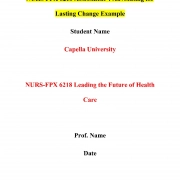 NURS FPX 6218 Assessment 4 Advocating for Lasting Change
NURS FPX 6218 Assessment 4 Advocating for Lasting Change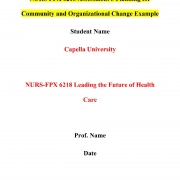 NURS FPX 6218 Assessment 3 Planning for Community and Organizational Change
NURS FPX 6218 Assessment 3 Planning for Community and Organizational Change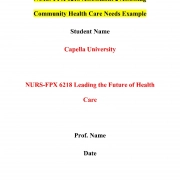 NURS FPX 6218 Assessment 2 Assessing Community Health Care Needs
NURS FPX 6218 Assessment 2 Assessing Community Health Care Needs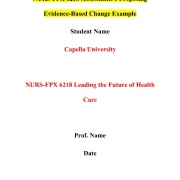 NURS FPX 6218 Assessment 1 Proposing Evidence-Based Change
NURS FPX 6218 Assessment 1 Proposing Evidence-Based Change NURS FPX 6216 Assessment 4 Preparing and Managing a Capital Budget
NURS FPX 6216 Assessment 4 Preparing and Managing a Capital Budget NURS FPX 6216 Assessment 3 Budget Negotiations and Communication
NURS FPX 6216 Assessment 3 Budget Negotiations and Communication NURS FPX 6216 Assessment 2 Preparing and Managing an Operating Budget
NURS FPX 6216 Assessment 2 Preparing and Managing an Operating Budget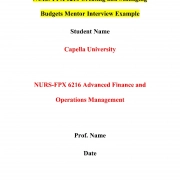 NURS FPX 6216 Assessment 1 Instructions: Mentor Interview
NURS FPX 6216 Assessment 1 Instructions: Mentor Interview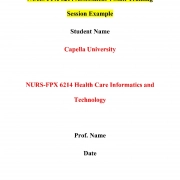 NURS FPX 6214 Assessment 4 Staff Training Session
NURS FPX 6214 Assessment 4 Staff Training Session